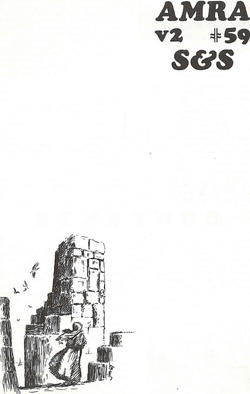Читать книгу Amra, Vol 2 No 59 - George H. Scithers - Страница 6
На сайте Литреса книга снята с продажи.
Japanese Swords
Оглавлениеby Mark Walsted
In all discussions of swords in Amra I have seen nothing about the best swords. They are better in design, construction, and material than the almost legendary Toledo and Damascus blades, and are the most sophisticated hand weapons in history. They were to be used against armor, so the smiths had the same problems faced in other parts of the world. A sword must be light to carry. It must not bend, but it must not break either. It should have a uniform cutting efficiency along its whole length. The Japanese solved these interlocking problems in a unique way.
The first step in forging a sword was a prayer to a patron deity, repeated at the beginning of every working day. Then iron of suitable quality was forged into a flat plate. This was heated until malleable, folded, and pounded flat again. This process was repeated many times, sometimes as many as thirty. Two pieces which had been forged and folded separately could be fitted together at the last folding to form a sword of softer steel at the core and harder steel on the skin. The final plate was pounded into the shape of a stick and then shaved and filed into final form. The whole blade was covered with clay, scraped thin at the cutting edge so the temper will be greater along that edge. Then the blade, clay and all, was heated to a specified, exact temperature and plunged into water. The sword was next ground to its final shape with a coarse stone. Then the tang was finished and inscribed with the smith’s name. Final polishing, sharpening, and mounting were done by other specialists.
In looking at a good sword the first impression is that it is extraordinarily bright. The final polishing puts a mirror finish on the blade. As one looks along the cutting edge it appears as straight as the eye can judge. Indeed the whole sword has a remarkable symmetry. The most beautiful part of the sword is the tempering edge. Most of these are irregular, wavy lines, running the length of the sword, showing where the highly tempered steel of the cutting edge changes to the less tempered steel of the body of the sword. The grain of the metal, caused by folding, may show up under special polishing treatment, but in general it is not visible. The advantages of this construction are a highly tempered edge that holds its sharpness and a backing of softer metal that will not break, even when used against armor.
There is a Japanese training film made during World War II which shows a man cutting the barrel of a machine gun in two with such a sword. Don’t try it. It can be done by an expert, but you may ruin a fine sword if you strike wrong.
All these advantages are nothing compared with that given by the mounting. The result is a sword which can cut or thrust, which can be used two handed or single handed with equal ease. The hilt is as long as the breadth of three hands, giving the user a remarkable degree of control.
For a sword so well adapted to thrusting it is surprising that there is only one thrust used in Japanese swordplay. It is forbidden in formal fencing because it is so dangerous. This is a thrust at the neck. For a demonstration of this see the movie SAKURO if you get a chance. There, the thrust is coupled with a fast draw, and it is all over before you realize that anything is happening. Everything sort of explodes.
Fast draws are as highly regarded in Japan as in the American Old West. One exercise in contests goes like this: One man will draw, cut off a branch of a tree over his head, and sheathe the sword before the branch hits the ground. But don’t try this yourself; you may stick yourself in the stomach!
I can’t but wonder what would happen if Cyrano de Bergerac fought Yoshitsune, but I wouldn’t bet on Cyrano.
#############
